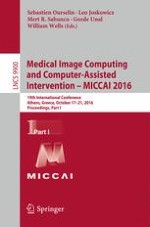The three-volume set LNCS 9900, 9901, and 9902 constitutes the refereed proceedings of the 19th International Conference on Medical Image Computing and Computer-Assisted Intervention, MICCAI 2016, held in Athens, Greece, in October 2016.
Based on rigorous peer reviews, the program committee carefully selected 228 revised regular papers from 756 submissions for presentation in three volumes. The papers have been organized in the following topical sections: Part I: brain analysis; brain analysis - connectivity; brain analysis - cortical morphology; Alzheimer disease; surgical guidance and tracking; computer aided interventions; ultrasound image analysis; cancer image analysis; Part II: machine learning and feature selection; deep learning in medical imaging; applications of machine learning; segmentation; cell image analysis; Part III: registration and deformation estimation; shape modeling; cardiac and vascular image analysis; image reconstruction; and MR image analysis.
